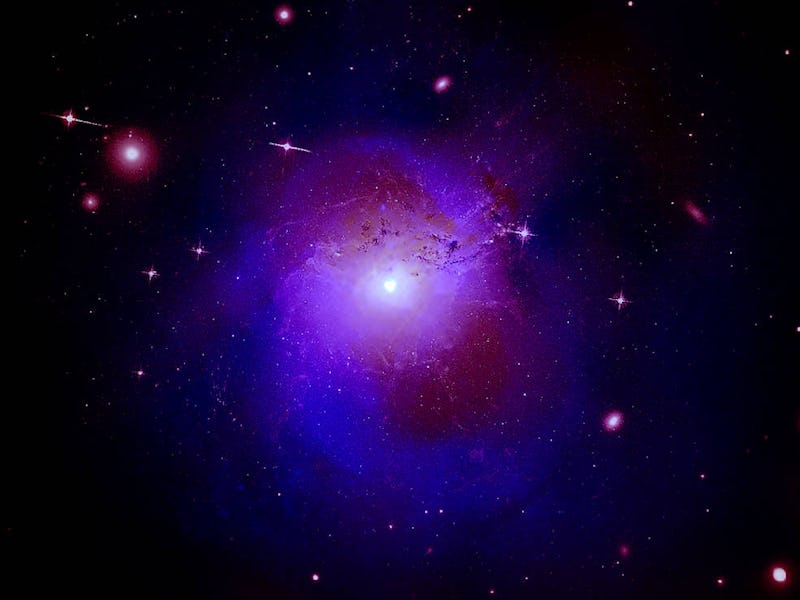Scientists may have found a strange way to detect dark matter collisions
The shockwave caused by the collision would break the sound barrier.

Although space is vast and expanding, things can still get a bit crowded as asteroids sometimes crash into planets, moons, or stars. And that’s just as far as we can see. But there may be some asteroids stranger than we can fathom.
The undetectable dark matter makes up around 85 percent of all matter in the universe, and scientists believe dark matter could behave similarly to regular matter in forming clumps that may be as big as asteroids.
In a recent paper, a team of scientists suggest that if those dark matter asteroids hit objects in the Solar System and beyond, they may produce shockwaves that could be detectable by the next generation of telescopes.
Their findings were published in the Physical Review Letter.
What are dark matter asteroids?
Dark matter is one of the universe’s biggest mysteries. It is a type of matter that doesn’t reflect, emit, or absorb light, and may only interact with other matter through gravity.
Although hidden, dark matter makes up around 27 percent of the universe's total mass, outweighing visible matter around six to one. Around 68 percent of the remaining mass is dark energy, with just five percent left to ordinary “baryonic” matter, which are the objects we can directly observe.
Researchers are quite confident dark matter exists — but they haven’t exactly been able to prove it with direct, observational evidence. They know it’s there given its gravitational effect on the motion of stars and galaxies, as dark matter moves galaxies in ways that all the observable matter can’t.
Scientists believe that dark matter particles can come together to form structures that can be as big as thousands of times the mass of the Milky Way or much smaller clumps the size of rocky asteroids.
“This happens with familiar matter, but we don't know if such objects can actually form with dark matter,” Philip Schuster, a theoretical physicist at Stanford University and co-author of the new paper, tells Inverse. “We found a way to look for asteroid-sized dark matter, which had been thought to be too rare to see, by its impacts on stars.”
Dark matter asteroids could be a culprit behind some solar flares.
What’s new — The same way regular asteroids hit other objects in space, perhaps these dark matter asteroids are also going around bumping into celestial objects such as stars.
“When meteorites hit our upper atmosphere here on Earth, they do so at supersonic speeds, and usually produce big fireballs,” Sebastian Ellis, a researcher at the University of Geneva and co-author of the study, tells Inverse. “When a dark matter asteroid hits a star, something similar happens.”
The collision between a dark matter asteroid and a star would happen at a supersonic speed, producing a shockwave that would break the sound barrier.
“This shockwave doesn’t stay in place, but instead travels through the star and spreads,” Ellis says. “The traveling shockwave heats up the stellar material as it passes through — only the energy deposited near the surface will escape in a reasonable amount of time to be detectable by telescopes near Earth.”
A patch of the star near the surface is heated to about 10,000 Kelvin (17,500 Fahrenheit), much hotter than the surrounding material, leading to a signal that ultraviolet telescopes can observe. The collision would have to be observed in real-time to detect traces of the violent event.
“The ultraviolet emission due to this dark matter collision would be above and beyond any background ultraviolet emission coming from the star prior to the collision,” Ellis says. “The ‘smoking gun’ of the collision is therefore in the form of a transient increase in ultraviolet brightness of a star, lasting a few hundreds of seconds, potentially longer.”
The signal would have a sudden uptick in ultraviolet emission from the star, with a smaller uptick in optical light emission and a much smaller X-ray blip. That X-ray blip comes from the dark matter passing through the atmosphere of the star.
WHAT’S NEXT — The researchers behind the new paper are awaiting the launch of the ULTRASAT telescope, which will perform an in-depth time-resolved all-sky survey in the near-ultraviolet spectrum.
“It is a telescope designed to search for violent, short-lived events in as wide a view as possible,” Ellis says. “This wide view allows for the monitoring of a large number of stars at a given time, enhancing the probability of detecting collision events.”
The telescope is scheduled for launch in the year 2024.
“If the signal we described in our paper is observed, and can be attributed to asteroid-like dark matter impacts, that would imply new forces and interactions unique to dark matter,” Schuster says. “Whichever way the data points, we will learn something new in our effort to understand the nature of dark matter.”
Abstract — Macroscopic dark matter is almost unconstrained over a wide “asteroidlike” mass range, where it could scatter on baryonic matter with geometric cross section. We show that when such an object travels through a star, it produces shock waves that reach the stellar surface, leading to a distinctive transient optical, UV, and x-ray emission. This signature can be searched for on a variety of stellar types and locations. In a dense globular cluster, such events occur far more often than flare backgrounds, and an existing UV telescope could probe orders of magnitude in dark matter mass in one week of dedicated observation.
This article was originally published on